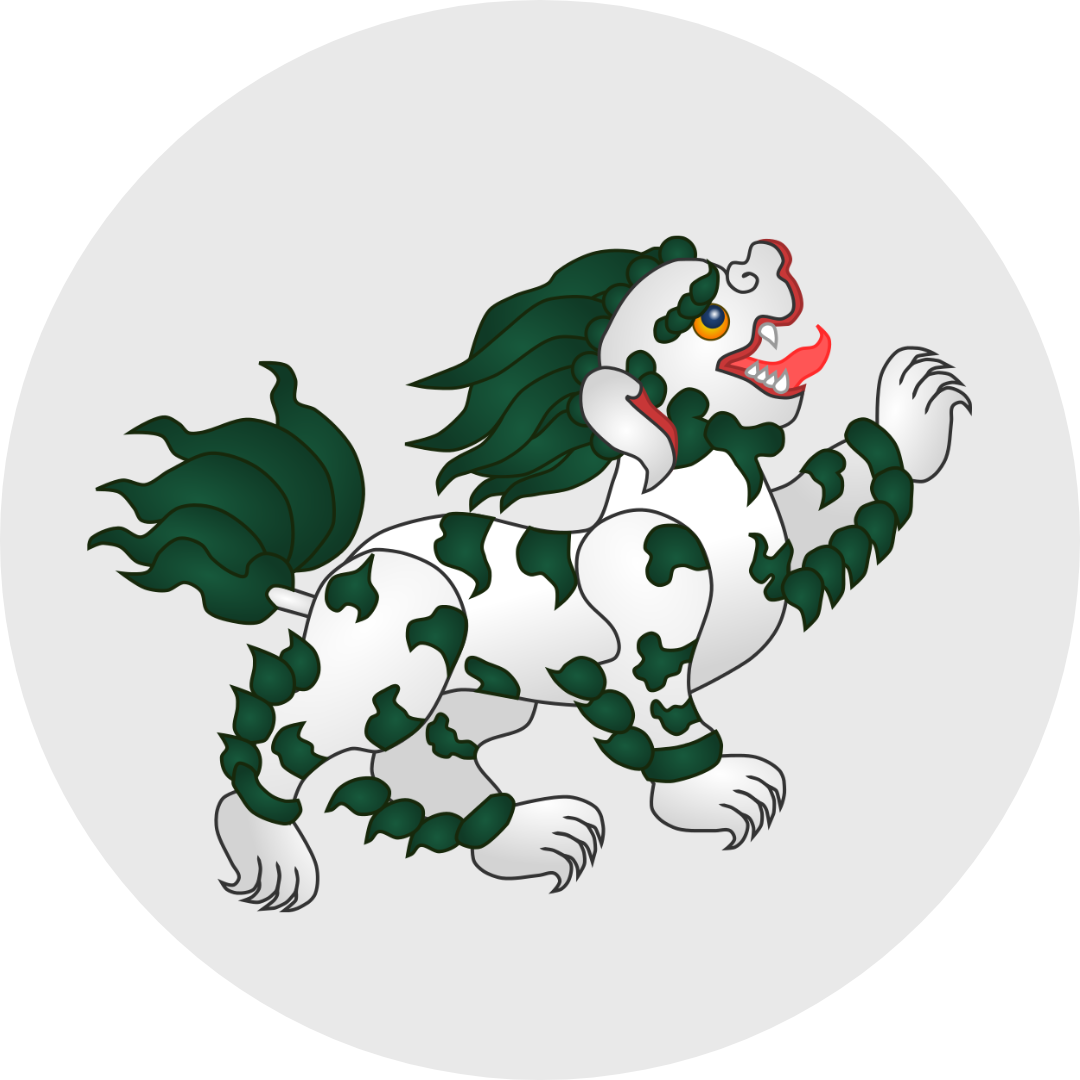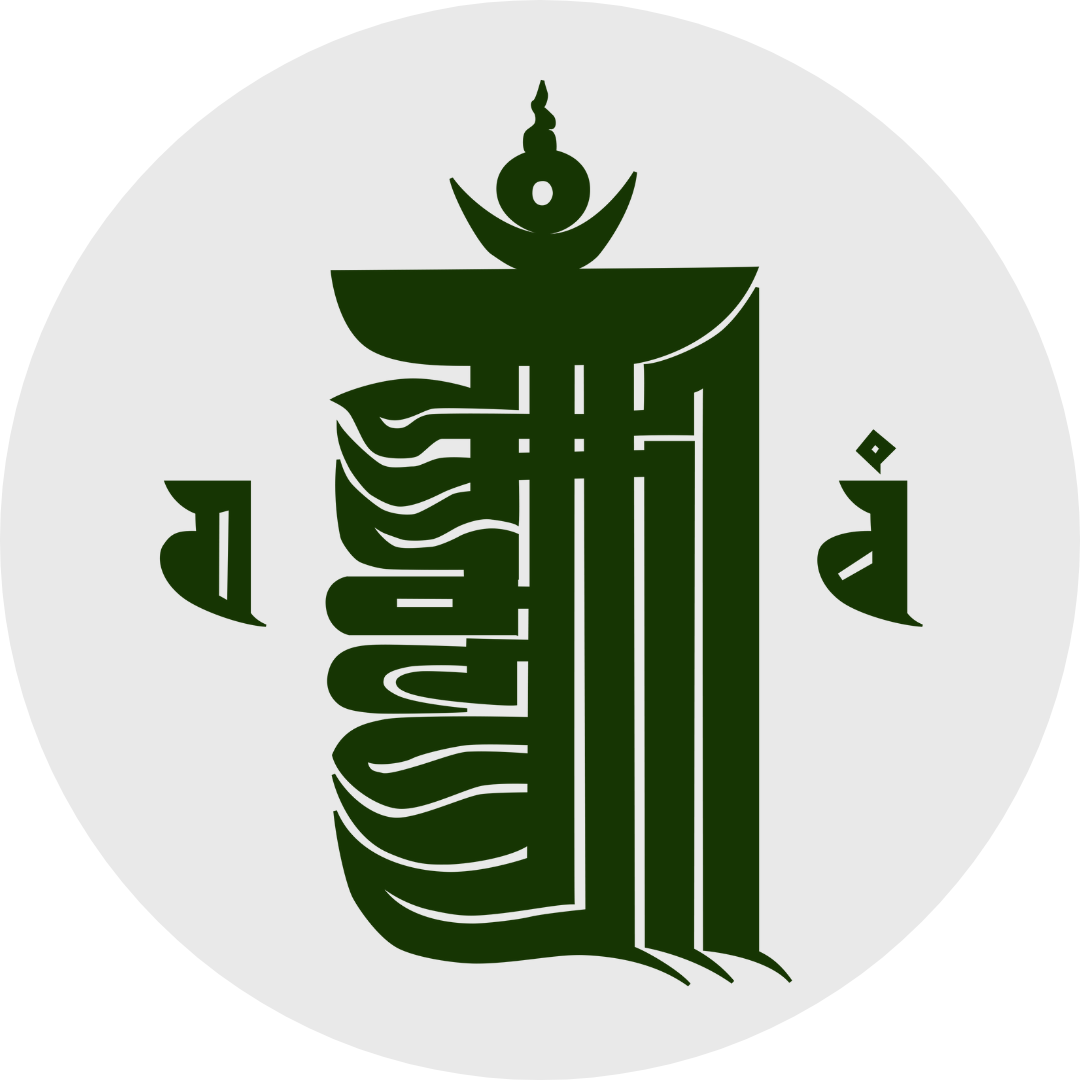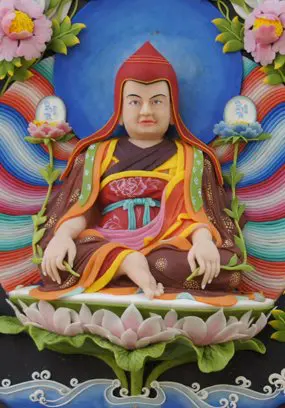Linia noastră de descendență
Deși avem practici din mai multe linii diferite de descendențe, practica noastră de Kalachakra se bazează pe Dharma Dzokden și Linia de descendență Jonang.Tradiția Jonang e vitală pentru lumea noastră
Deși puține cercuri academice din afara tradiției noastre au auzit vreodată de Jonang, aceasta nu este o tradiție nouă. Adepții Jonang își regăsesc linia de descendență din India și de la marea universitate Nalanda. Totuși ea nu a devenit cunoscută sub numele de Jonang până când fondatorul său, Kunpang Thukje Tsondru, nu s-a stabilit în valea Jomonang din Tibet, în timpul secolului al XIII-lea.
Unul dintre motivele pentru care atât de puțini oameni au auzit în prezent de tradiția Jonang se datorează faptului că adepții ei nu au fugit din Tibet în 1959. Prin urmare, atunci când Administrația Tibetană din Exil a început să înregistreze tradițiile, cei din Jonang au lipsit (în India). Prin urmare, foarte puținor străini (non-tibetani) le-au fost prezentate învățăturile autentice ale tradiției Jonang.
Abia în 1990 au început să iasă din Tibet primii călugări Jonang. De atunci, ei au cerut administrației tibetane să recunoască tradiția lor ca fiind demnă de respect egal cu cel acordat tradițiilor Nyingma, Kagyu, Sakya, Gelug și Bön. Deși s-au făcut progrese mari în acest sens, din păcate această lucrare nu este încă finalizată.
Pentru că Jonang sunt deținătorii de bază ai următoarelor două linii importante de descendență, este crucial să înflorească Dharma Jonang. Eșecul acesteia va conduce la pierderea acestor sisteme spirituale de neînlocuit.

Zhentong
Filosofia Zhentong Madhyamaka este recunoscută drept cea mai înaltă viziune de către mulți dintre cei mai realizați maeștri tibetani. Jonang este singura dintre cele cinci școli budiste majore tibetane care subliniază această doctrină unică și îi susține Linia de descendență.

Kalachakra
Tantra Kalachakra este cel mai cuprinzător și eficient sistem din budismul tibetan. Jonang este singura tradiție care deține întregul sistem Kalachakra, inclusiv practica unică de desăvârșire cunoscută sub numele de „Cele Șase Vajra Yoga”.
#RECOGNIZEJONANG
Drepturi egale pentru tradiția Jonang
Creșterea gradului de conștientizare cu privire la tradiția Jonang
Linia de descendență din Sutra a Zhentong Madhyamaka
Viziunea Zhentong definitivă a fost predată pentru prima dată de Buddha Shakyamuni în a doua și a treia întoarcere a Roții Dharmei, fiind transmisă doar devotaților ale căror minți erau considerate coapte pentru aceste învățături profunde. Pe baza acestor învățături, Bodhisattva Maitreya, regentul lui Buddha Shakyamuni, a predat cinci mari tratate:
- Ornamentul realizării clare (Skt. Abhisamayalankara)
- Ornamentul Sutrelor Mahayana (Skt. Mahayanasutralankara)
- Distingerea mijlocului de extreme (Skt. Madhyantavibhaga)
- Distingerea Dharmei și Dharmatei (Skt. Dharma-dharmata-vibhaga)
- Sublimul Continuum (Skt. Uttaratantra Shastra)
Aceste texte i-au fost transmise lui Asanga, un călugăr care, după ce a meditat într-o peșteră timp de 12 ani, a avut o viziune cu Maitreya. Linia de descendență a fost transmisă ulterior de mari maeștri indieni, precum Vasubandhu, Saraha și Gangamaitri și alții. A ajuns în Tibet în secolul al XI-lea, prin traducătorul Zi Lotsawa Gawé Dorje și prin Tsen Khawoche Drimé Sherab, și a fost transmisă într-o linie neîntreruptă până la omniscientul Dolpopa Sherab Gyaltsen, în secolul al XIV-lea.
LINIA DE MAEȘTRI
Sursa
1. Primordial Buddha (Svabhavikakaya)
2. Vajradhara (Dharmakaya)
3. Vajrasattva (Sambhogakaya)
4. Buddha Shakyamuni (Nirmanakaya)
5. Bodhisattva Maitreya
Yogacara Madhyamaka a lui Asanga
6. Arya Asanga
7. Vasubandhu
8. Dignaga
9. Sthiramati
10. Chandragomin
Tradiția contemplativă a lui Maitreya
11. Maitripa
12. Ratnakarashanti
13. Anandakirti
14. Sañjana
15. Lotsawa Gawa’i Dorje
16. Tsen Kawoche Drimé Sherab
17. Dharma Tsondru
18. Yeshe Jungné
19. Jangchup Kyap
20. Zhonnu Jangchup
Linia de descendență din Narthang
21. Monlam Tsultrim
22. Chomden Rigpé Raldri
23. Kyiton Jamyang Drakpa
Linia de descendență a Jonang Zhentong
24. Kunkhyen Dolpopa Sherab Gyaltsen
25. Chögyal Choklé Namgyal
26. Tsungmed Nyabön Kunga
27. Chöjé Pal Gonpo
28. Lodrö Gyatso
29. Donyöd Pal
30. Panchen Shakya Chokden
31. Donyon Drubpa
32. Jamgön Drubpa Pawo
33. Kunga Gyaltsen
34. Drakden Drubpa
35. Jetsun Taranatha
36. Ngonjang Rinchen Gyatso
Linia de descendență a Dzamthang Tsangwa
37. Khidrup Lodrö Namgyal
38. Drupchen Ngawang Trinlé
39. Ngawang Tenzin Namgyal
40. Ngawang Khetsun Dargé
41. Kunzang Trinlé Namgyal
42. Nuden Lhundrub Gyatso
43. Konchok Jigmé Namgyal
44. Ngawang Chöphel Gyatso
45. Ngawang Chökyi Phakpa
46. Ngawang Chöjor Gyatso
47. Ngawang Chözin Gyatso
Linia de descendență a Jonang Chamda
48. Kunga Khedrub Wangchuk
49. Rinchen Zangpo
50. Rinchen Öser
51. Ngawang Lodrö Drakpa
52. Kunga Sherab Saljé
53. Khentrul Jamphel Lodrö

Linia tantrică de descendență Kalachakra Vajra Yoga
Se spune că Buddha a predat pentru prima dată aceste învățături tantrice secrete în Drepung din sudul Indiei (Amaravati). Principalul destinatar al acestor învățături a fost regele Suchandra din Shambhala. Regele Suchandra a scris un text cu învățăturile tantrice primite și a compus comentarii la ele. Linia de descendență a fost deținută de către 7 regi Dharma și apoi de 11 Kalki, înainte de a fi transmisă din Shambhala în țara Indiei.
Învățăturile Kalachakra nu au fost practicate în India înainte de secolul al X-lea. Totuși, se spune că marele Mahasiddha indian Manjuvajra a dobândit puteri miraculoase și a călătorit în Shambhala. La întoarcere, el a transmis linia de descendența discipolului său Shribhadra.
Discipolul lui Shribhadra, marele Pandita Dawa Gonpo, și-a petrecut cea mai mare parte a vieții sale în Tibet, lucrând cu traducătorul Dro Lotsawa pentru a traduce integral învățăturile din Kalachakra. Linia de descendență a fost apoi transmisă prin mai mulți maeștri tibetani, cum ar fi Lama Lhaje Gompa, Lama Droton Namsek și marele Yumo Mikyo Dorje, care au împărtășit apoi aceste învățături pe scară largă.
În secolul al XIII-lea, Kunpang Thukje Tsondru a primit transmisii de la peste 17 linii de descendență de Kalachakra, de la mulți maeștri diferiți, și a petrecut mulți ani în retragere, practicând cele șase Vajra Yoga într-un loc cunoscut sub numele de Jomonang. Acesta a devenit ulterior locul principalei mănăstiri Jonang, cunoscută și sub numele de a doua Shambhala. Thukje Tsondru a combinat apoi aceste linii de descendență într-o singură linie de practică extraordinară, care a devenit nucleul curriculum-ului tradiției Jonang de atunci, până în prezent.
LINIA DE DESCENDENȚĂ A MAEȘTRILOR
Sursa
1. Primordial Buddha (Svabhavikakaya)
2. Vajradhara (Dharmakaya)
3. Kalachakra (Sambhogakaya)
Regii Dharmei și Kalki din Shambhala
4. Suchandra
5. Sureshvara
6. Taji
7. Somadatta
8. Sureshvara
9. Vishvamurti
10. Sureshana
11. [Manjushri] Yashas
12. Pundarika
13. Badra
14. Vijaya
15. Sumitra
16. Raktapani
17. Vishnugupta
18. Arkakirti
19. Subhadra
20. Samudravijaya
21. Aja
Tradiția Kalachakra din Nalanda
22. Manjuvajra
23. Shri Badra
24. Bodhibadra
25. Somanatha
Linia de descendență Dro a Celor Șase Vajra Yoga
26. Drotön Lotsawa
27. Lama Lhaje Gompa
28. Lama Drotön Namseg
29. Lama Drupchen Yumo
30. Tséchok Dharmeshvara
31. Khipa Namkha’i Öser
32. Machig Tulku Jobum
33. Lama Druptop Sechen
34. Chöje Jamyang Sarma
35. Kunkhyen Chöku Öser
Linia de descendență Jonang Kalachakra
36. Kunpang Thukje Tsondru
37. Jangsem Gyalwa Yeshe
38. Khetsun Yonten Gyatso
39. Kunkhyen Dolpopa Sherab Gyaltsen
40. Chögyal Choklé Namgyal
41. Tsungmed Nyabön Kunga
42. Drupchen Kunga Lodrö
43. Jamyang Konchog Zangpo
44. Drenchok Namkha Tsenchen
45. Panchen Namkha Palzang
46. Lochen Ratnabhadra
47. Palden Kunga Drolchok
48. Kenchen Lungrik Gyatso
49. Jetsun Taranatha
50. Ngonjang Rinchen Gyatso
Linia de descendență din Dzamthang Tsangwa
51. Khidrup Lodrö Namgyal
52. Drupchen Ngawang Trinlé
53. Ngawang Tenzin Namgyal
54. Ngawang Khetsun Dargé
55. Kunzang Trinlé Namgyal
56. Nuden Lhundrub Gyatso
57. Konchok Jigmé Namgyal
58. Ngawang Chöphel Gyatso
59. Ngawang Chökyi Phakpa
60. Ngawang Chöjor Gyatso
61. Ngawang Chözin Gyatso
Linia de descendență din Tashi Chöthang
62. Ngawang Tenpa Rabgye
63. Ngawang Lobsang Trinlé
64. Khentrul Jamphel Lodrö
Comunitatea monahală Jonang
Dolpopa Sherab Gyaltsen a fost un maestru incredibil de influent. Printre numeroasele sale realizări, el a dezvoltat un sistem unificat de practică, care a combinat viziunea Zhentong din sutre cu practicile tantrice Kalachakra. Prin acest sistem, practicanții și-ar dezvolta inițial viziunea prin meditarea asupra semnificației „Celor Cinci tratate” ale lui Maitreya. Apoi ei ar obține realizările directe prin practica Kalachakra. Ulterior, Kunga Drolchok și Taranatha au extins acest sistem, clarificând și mai mult multe dintre învățăturile extraordinare ale lui Dolpopa.
Deși primii maeștri Jonang au fost foarte activi din punct de vedere academic, din cauza obstacolelor politice care au apărut în secolul al XVII-lea, majoritatea practicanților Jonang au început să se concentreze din ce în ce mai mult pe practica lor spirituală (și nu cea scolastică). Ca rezultat, tradiția Jonang a dezvoltat o realizare profundă, uriașă, care îi permite să ofere cea mai completă înțelegere a sistemului Kalachakra.
Având în prezent peste șaptezeci de mănăstiri și centre de retragere în Tibet, în special în regiunile Kham și Amdo, tradiția Jonang continuă să înflorească. Numai în Mănăstirea Dzamthang sunt peste 5000 de călugări ce studiază actualmente viziunea Zhentong Madhyamaka, precum și cele cinci tematici majore ale filozofiei budiste, utilizând textele lui Dolpopa și ale altor venerați maeștri Jonang. A devenit o parte tradițională a antrenamentului în mănăstirile tradiției Jonang practicarea a minimum unei retrageri de trei ani în Kalachakra, și există chiar și astăzi mulți yoghini angajați în retragerea pe viață, practicând cele șase Vajra Yoga.
Datorită bunăvoinței unor maeștri precum Khentrul Rinpoché, lumea modernă capătă treptat acces la înțelepciunea străveche a acestei tradiții profunde.

MĂNĂSTIRILE AFILIATE CU KHENTRUL RINPOCHÉ
În timpul vieții sale, Khentrul Rinpoche a avut onoarea de a studia în peste 11 mănăstiri, din fiecare dintre principalele tradiții ale budismului tibetan. Dintre acestea, el are o legătură deosebit de puternică cu patru mănăstiri proeminente ale tradiției Jonang din regiunea Golok/Amdo din Tibetul de Est. Aceste mănăstiri reprezintă sursa principală a tradiției Kalachakra pe care Rinpoche o susține în Occident:
Mănăstirea Dzamthang Tsangwa
Mănăstirea Tashi Chöthang
Mănăstirea Jonang Chamda
Mănăstirea Longkya Mingyur Dechen Ling